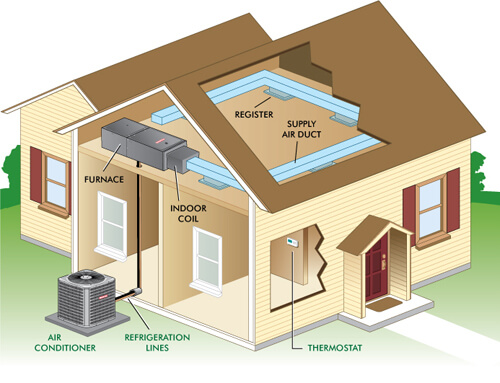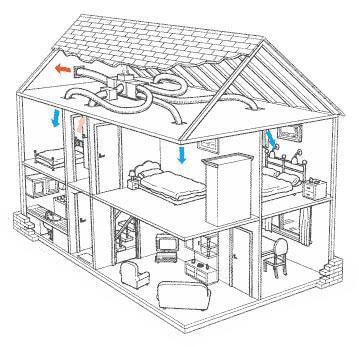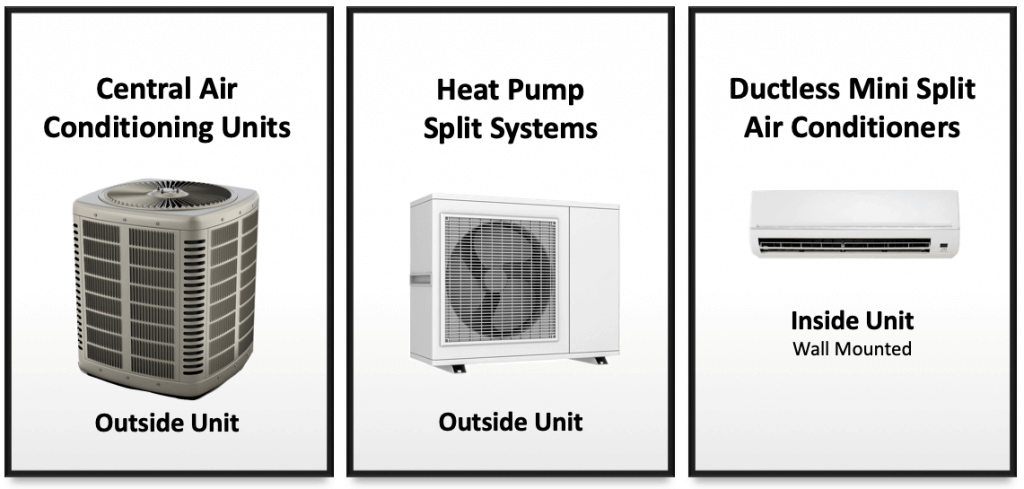
Did you know that a guy named Willis Haviland Carrier is considered the father of the air conditioner?
His brainchild, sending air through coils filled with cold water, proved one of the most remarkable inventions of 1902, though Carrier’s idea actually had roots in second-century China when inventor Ding Huane crafted the first manually-powered rotary fan. We would be remiss not to mention Benjamin Franklin, whose efforts in 1758 to experiment with alcohol and evaporation to achieve freezing temperatures also deserve a shout-out.
Fortunately, Carrier’s fascination with mechanical cooling didn’t meet the same fate as Franklin’s. He didn’t move on to another interest, which is how the Carrier Air Conditioning Company of America came to be born. His amalgam of belt-driven condensers, blower, control, and evaporator coils formed the foundation of the system we know today – so next time you escape from blistering July heat, you can thank Carrier!
Key Takeaways
- Central ACs use a single outdoor unit to cool the entire home via a system of indoor vents and ductwork. More efficient than room units.
- Main types are split ducted systems with separate indoor and outdoor units, and ductless mini-split systems with wall-mounted indoor units.
- Key factors: cooling capacity, energy efficiency rating (SEER), noise level, zoning capabilities, smart controls.
- Prices range from $1500-$14,500 for the unit, plus $1000-$7300 for installation. Higher upfront cost but greater efficiency.
- Look for high SEER ratings of 19+ for energy savings. Inverter compressors provide smooth, quiet operation.
- Consider professional installation for optimum performance, unless you have HVAC expertise. Ductwork placement is complex.
- Regular maintenance improves lifespan – change filters, clean coils, check refrigerant charge. Protect outdoor unit.
- Top brands: Hitachi, Samsung, Mitsubishi Electric, Carrier, Panasonic, Daikin, LG. Rated for reliability and efficiency.
- Zoned systems allow cooling only occupied rooms to save energy. Programmable thermostats add convenience.
- Ductless systems an option if no existing ductwork. Less efficient than ducted central ACs.
Central air conditioning is a type of air conditioning system that uses a single, central unit to cool a building or multiple rooms in a building. The central unit, which is typically located outdoors, contains a compressor, a condenser, and an evaporator. It is connected to a system of ducts, which are used to distribute cooled air throughout the building.
Central air conditioning systems are often used in residential and commercial buildings because they offer a number of benefits, including:
- Consistent, comfortable temperatures throughout the entire space
- Quiet operation (since the central unit is located outside)
- Energy efficiency (since the air is distributed through a system of ducts, rather than using multiple individual units)
There are several types of central air conditioning systems, including split systems, which have an indoor unit and an outdoor unit, and packaged systems, which have all of the components in a single unit that is typically located on the roof or outside the building.
To determine the best central air conditioning system for your needs, it’s important to consider the size of the space you want to cool, the climate you live in, and your budget. It’s also a good idea to consult with a professional HVAC (heating, ventilation, and air conditioning) technician to determine the best system for your specific needs.
Best Air Conditioner – Review of 2020
The evolution of the air conditioner

According to Consumer Reports research , more than 75-percent of all U.S. homes use air conditioning of some type, and “90-percent of new homes are equipped with central air.” Given this huge increase in central air system installations, it’s no wonder the HVAC industry managed to develop systems that prioritize energy efficiency so it costs less to run these systems than ever before.
Factors contributing to these advances include the contribution of SEER, AFUE, HSPF ratings, more efficient design that makes today’s system produce cooler air, multi-stage and single-stage energy conservation options, variable speed blowers, air-source pumps and a variety of system sizes that more accurately match interior space to the amount of cooling a home needs without wasting energy. Of course, installation is a big factor in the way a system performs, which is why it will always play a significant part in the performance of a unit.
Types of central air conditioners

Raise your hand if you assumed that there was just one central air conditioner type. You’re not alone. Though the most typical type is referred to in the trade as “a split system,” the only split part about the design is that the schism takes place within the external part. These large, boxy units are installed outside the home and consist of a fan-and-coil network that’s joined by pipes so the refrigerant can be circulated throughout the air conditioner and a condenser/compressor duo funnels the cooled air into the blower that distributes it throughout a structure.
But for homes and buildings that have no ductwork due to design, age, or space, split-ductless systems do the job of cooling interiors. These less-complicated units consist of an outside compressor and condenser plus a range of indoor blower units. Known as “fan coils” in the industry, a split ductless system features from one to four blowers, though if a central air conditioner is sophisticated enough, there could be more than four.
These indoor blowers are easily recognized because they are installed fairly high on walls for adequate distribution of air. Both indoor and outdoor components are joined by a thick conduit that encases the power cable, tubing necessary for refrigerant to be distributed and a condensate drain helps rid the unit of built-up moisture.
There’s one more element that distinguishes a ductless from a ducted system: the nerve center (that slim conduit) distributes cooled air via a small hole in the wall or ceiling that measures as little as 3-inches, thereby pairing every air handler with the room it serves. The remote control is used to cool each room separately.
Here’s a trivia fact you can share with folks who think they know everything about air conditioning: Ductless systems are not considered “real” central air units, though you’ll pay more to have one installed. So why is this type of system usually included in a description of central air types? Because if you were blindfolded, you wouldn’t be able to tell the difference. Each delivers relief room dwellers crave, especially during steamy summer months.
Who’s up for the install? You or a contractor?
Installing a central air conditioning system these days is not your grandfather’s scene, but the process and protocols involved with the install are very formulaic. Steps to take once you have determined whether your structure will require a ducted or ductless system are the following if you intend to do the job yourself:
1. Determine the amount and type of wall and attic insulation that is in place, factor in the types and locations of windows and doors as well as the direction your home faces in relation to the sun. By doing this first you could determine that you need more insulation material to get the maximum amount of cooling from the unit you pick.
2. Make Air Conditioning Contractors of America Manual J load calculations. This impressive-sounding calculation isn’t difficult to undertake yet it’s critically important because the result of the math will determine heat gain and point you in the direction of the size you need.
3. Having decided on the right size unit for your building, consider only systems that fit seasonal energy-efficiency ratings (SEER) that determine how much each watt of electricity will be required based on home size. The higher the SEER number, the cheaper it will be to run your air conditioning system. By the way, the government has mandated a minimum SEER rating of 13 for every new system in today’s market as well as an assortment of new safety features.
4. Determine where to install. This is important because condensers make noise so situating the unit near the window or door of a room in which you spend a lot of time could make you regret the fact that you didn’t think this through. If you’re not installing a split system outdoors, your attic is likely the place it winds up if the product you choose isn’t compatible with forced air. Of particular importance, in either case, is that there is no obstruction (shrubs, hedges, attic clutter, etc.) to reduce the efficiency of the system.
5. Duct installation, if required to get your central air conditioning working, is going to be a messy process, whether you place these outlets in the ceiling or the wall. Every room is going to need an assortment registers/vents/grills/filters to handle the air exchange as your unit sucks up hot and delivers cooled air.
How much does it cost to replace central air conditioners?
According to Abc-Air, the cost of your replacement will be determined by the brand, current market pricing, type of unit, whether or not you do the install or you hire a contractor, the size of your building, and the capacity of a/c machine. That’s why there is such a wide pricing range associated with replacing a central unit.
While Home Advisor experts say the unit price range is vast — between $1500 and $14,500 to install a ductless mini-split product — they also calculate a cost of between $1000 and $7,300 for labor.
If you’re not doing the install, a unit and labor package is currently estimated to run anywhere between $1000 and $16,000. A visit to this page spells out a variety of options you will want to consider before you hire a contractor or decide to do the job yourself.
The care and feeding of your system once it is installed
- Seal and insulate your ducts so you don’t lose energy.
- Maintain a regular cleaning schedule so dirt and debris don’t clog up an outside unit or interfere with the operation of an attic or basement unit.
- Each season, change filters, clean and flush coils, drain the pan and vacuum the blowers.
- Keep tabs on refrigerant.
- If you don’t want to do regular maintenance tasks yourself, purchase a service plan, and let an expert do the job.
- Install a programmable thermostat over a regular one for optimal efficiency.
Pros and cons of central air conditioners
Since HGTV is today’s most popular conduit for information related to homes and gardens, seeking a list of pros and cons associated with the addition or replacement of central air conditioning products offers shoppers a balanced guide that can determine which system makes the most amount of sense for your structure, lifestyle, needs and wants. As you shop for products, take these into consideration.
Pros
- You’ll stay cooler and more productive in a centrally air-conditioned home that you would if you left window units in place.
- You enjoy options: split ductless or ducted. Both have merits in terms of where you prefer to install the system and whether or not you want it in a conspicuous location or outside where you can ignore it.
- Choose a zoned system and you can close off rooms that aren’t being used and focus the cool air only on rooms that are being occupied.
- Your kitchen is likely to stay cooler in summer and sleeping advantages of central air when it’s hot are priceless.
- Today’s HVAC systems can deliver cool and warmth, which makes ductless types a favorite in geographic locations that tend to experience extreme weather.
- Some units come with remote controls and wi-fi so you don’t have to move from the couch or your bed to adjust the temperature or turn the unit on or off.
Cons
- If your home is large, you’ll spend a lot of money on the unit you wind up buying.
- Running an air conditioner for long periods of time can tax a utility budget.
- Not every homeowner loves the site of a clunky unit ruining landscaping when the outside installation is the only option.
- The outdoor placement could lead to compressor/condenser problems or replacement issues due to the unit’s vulnerability to weather and other assaults.
- Once in, your central unit is there for the long haul. Repositioning the system or undertaking major repairs will make you glad you insisted on the longest possible warranty and/or entered into a maintenance agreement.
- If not properly attended to, basement and attic systems can become mold and mildew ridden, triggering serious respiratory illnesses in those occupying the building.
What are the best central air conditioner brands for 2020?
According to several reputable websites, the most highly rated central air conditioning brands, based on consumer satisfaction, component and material quality, durability, warranty, and value for 2020 are:
1. Hitachi (SEER rating: 22)
2. Samsung (SEER rating: 19)
3. Mitsubishi Electric (SEER rating: 24.5)
4. Carrier (SEER rating: 21)
5. Panasonic (SEER rating: 21)
6. Daikin (SEER rating: 26)
7. LG (SEER rating: 20)
8. Actron (SEER rating: 19)
9. Fujitsu (SEER rating: 23)
10.Teco (SEER rating: 20)
FAQ
How much does it cost to install central air conditioning?
The installation cost depends on the building size and its technical features. The price is influenced by the model and the need to lay air ducts between floors. On average, installing a central air conditioner costs from $ 3,760 to $ 7,270.
Is Central AC expensive?
The unit prices range from $ 1,500 to $ 14,500. The price is influenced by the number of required air ducts and their length. Energy efficient models are the most expensive, but they cut operating costs by 30-50%.
How many years does a central air conditioner last?
Average cost central air conditioners last from 12 to 15 years. Expensive energy-efficient models are less prone to wear and tear and work great for 20 years. Low-power short-cycle models turn on and off quickly, causing excessive wear on the compressor, so they last about 10 years.
Is central air the same as air conditioning?
A central air serves to force air into the room but does not cool it. An air conditioning uses vents to supply air and cools it with a compressor in the outdoor unit.
